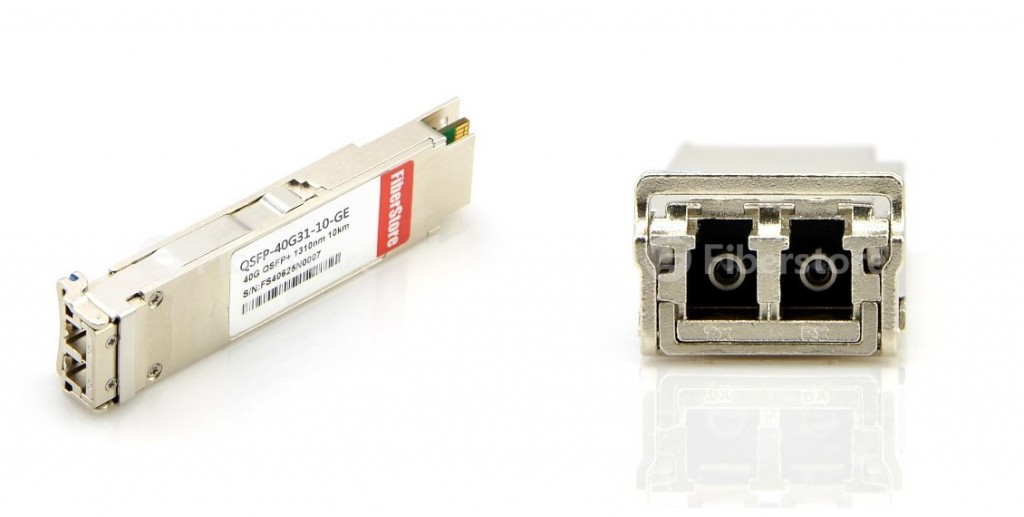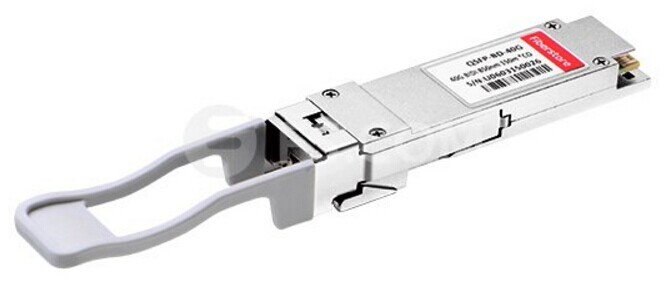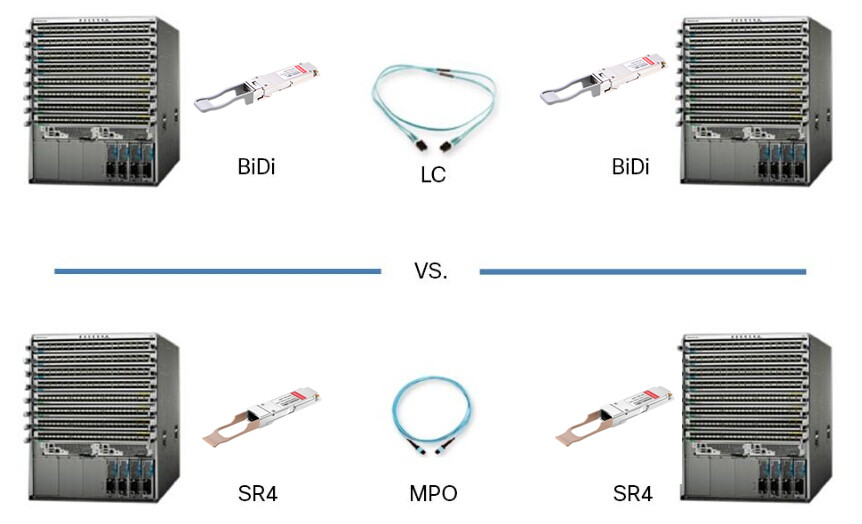Since the overwhelming growth in data traffic, many data centers are loaded with 10G and 40G based Ethernet switches for 10G to 40G migration. 40G switches allow the configuration of 40G port to act as one port or break out into four individual ports. To get easy 10G/40G migration, we should better select 40G QSFP+ transceivers which can break out as 4x10G connectivity. Among so many versions of 40G QSFP+ transceivers including QSFP-40G-SR4, QSFP-40-CSR4, QSFP-40G-LR4, QSFP-40G-ER4, etc., which 40G QSFP+ transceiver can be used for 4x10G?
QSFP-40G-SR4/CSR4 for 4x10G
40G short distance multimode transceivers are interfaced with 12-fibre MTP/MPO, such as 40G SR4, CSR4. To know why these 40G QSFP+ modules can be used for 4x10G, let’s see how QSFP-40G-SR4 work? First, 4 electrical input signals of 10G converted into parallel optical signals are sent from the transmitter over 4 parallel fibre strands. Then the parallel optical signals are converted into parallel electrical signals by the use of a photo detector array and transmitted to the receiver over another 4 parallel fibre strands. QSFP-40G-SR4 needs 8 fibres to transmit and receive signals. QSFP-40G-SR4 transceivers are interfaced with 12-fibre MTP/MPO. Therefore, QSFP-40G-SR4 and QSFP-40G-CSR4 transceivers can be easily broken down to 4x10G connections. Each 10G signal lane of QSFP-40G-SR4 is compliant to IEEE 10GBASE-SR specifications. And this 10G/40G connection can be achieved by using an MTP-LC harness cable or MTP cable and MTP-LC breakout patch panel to connect the QSFP-40G-SR4 and four 10GBASE-SR modules.
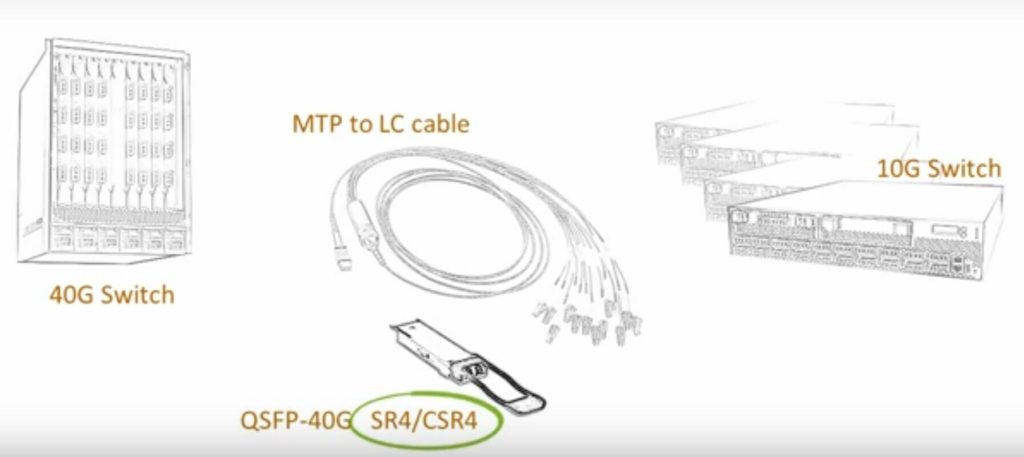
Can QSFP-40G-LR4/ER4 Be Used for 4x10G?
QSFP-40G-LR4 transceivers apply CWDM (Coarse Wavelength Division Multiplexing) technology. From the transmitter side, 4 input electrical signals of 10G are converted into 4 CWDM optical signals by a driven 4-wavelength distributed feedback (DFB) laser array. Then 4 CWDM signals are multiplexed to a singlemode fibre for 40G optical signal transmission. On the receiver side, the receiver accepts 40G CWDM optical signals input and demultiplexes them into 4 individual 10G optical data streams with different wavelengths. Multiplexing and demultiplexing of the four wavelengths are managed in the device. The 40 Gigabit Ethernet signal is carried over four wavelengths on a pair of singlemode fibres. The duplex fibres are used for bi-directional transmission. QSFP-40G-LR4 and QSFP-40G-ER4 are interfaced with duplex LC connector. Therefore, we can’t split QSFP-40G-LR4 or QSFP-40G-ER4 to 4 individual duplex SMF fibres to route them to 4 separate 10G transceivers by simple optical rerouting.
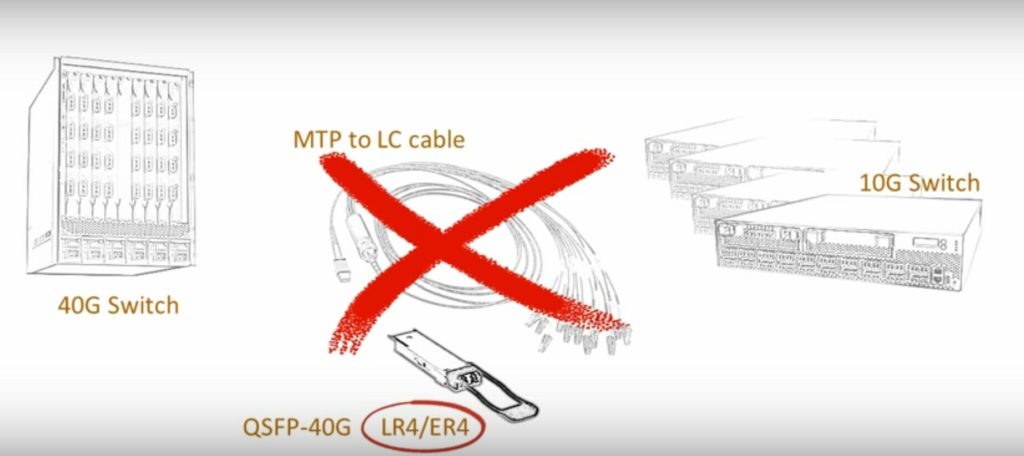
But if you insist to split the 40G into four 10G streams using QSFP-40G-LR4 or QSFP-40G-ER4 modules, how to achieve that connection? Then you need a simple multiplexer/demultiplexer which split the four wavelengths on duplex fibres into 4x10G signal in four different fibres. With such equipment, the QSFP-40G-LR4 or QSFP-40G-ER4 outputs can be physically broken down from one duplex fibre into four duplex fibres so that each of the wavelengths is transmitted in four different fibres (As the following figure shows).
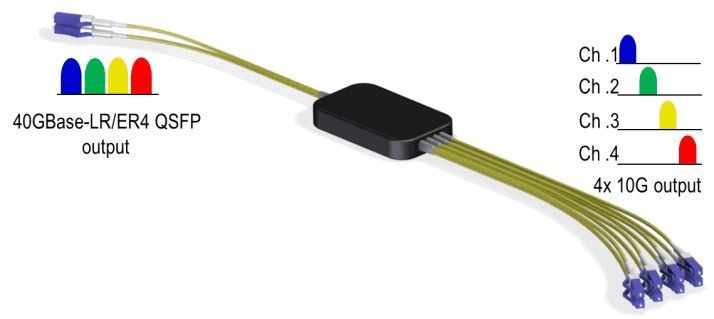
How About QSFP-40G-PLRL4?
From the above content, you may get an inclusion that multimode 40G QSFP+ transceivers can be directly used as 4x10G while singlemode 40G QSFP+ transceivers can’t. However, you ignore one singlemode transceiver QSFP-40G-PLRL4. This 40G QSFP+ transceiver connects with 12-fibre MTP/MPO patch cable though it’s designed for long distance transmission. Similar to QSFP-40G-SR4, QSFP-40G-PLRL4 also needs 8 fibres to transmit and receive signals. So you can easily get 10G/40G singlemode connection applying QSFP-40G-PLRL4.
Summary
Some data centres may face the issue of migration from 10G to 40G. Except the switch, you also need to know 40G QSFP+ transceivers well especially what kind of 40G QSFP+ transceivers can be used for 4x10G connectivity. In this article, you can see 40G QSFP+ transceivers with MTP/MPO interface can achieve that connection by simple optical routing. As to 40G QSFP+ transceivers with duplex LC interface, you need spare equipment for multiplexing/demultiplexing. For 40G to 4x10G solutions, you can find your desired one from FS.COM.
Related article: How to Extend 40G Connection up to 80 km?


